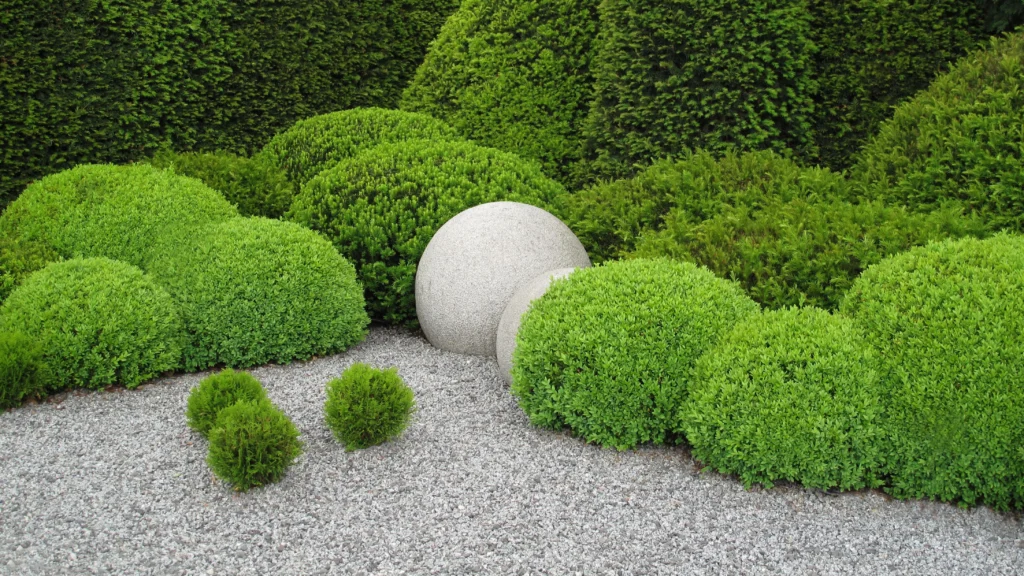Are you looking for a fast-growing, low-maintenance, and beautiful evergreen for your garden? The sprinter boxwood buxus might be the perfect plant for you. This exceptional shrub offers the classic elegance of a boxwood but with improved features that make it a standout choice for modern landscapes.
It provides year-round interest with its glossy green leaves and maintains a neat, upright shape with minimal effort. Whether you’re designing a formal hedge, creating a foundation planting, or adding structure to a container garden, this versatile plant delivers. This guide will cover everything you need to know about growing and caring for this fantastic shrub.
Table of Contents
Understanding the Sprinter Boxwood Buxus
The sprinter boxwood buxus is a specific cultivar of Buxus microphylla, also known as Japanese boxwood. It was developed as an improved version of the popular ‘Winter Gem’ boxwood. The main goal was to create a plant with a faster growth rate, allowing gardeners to establish hedges and fill spaces more quickly. It succeeded, offering not just speed but also excellent hardiness and a naturally upright, dense growth habit.
This means you get the lush, full look you want in less time. Its attractive, glossy foliage remains vibrant throughout the year, adding consistent color and texture to your landscape even in the depths of winter. This makes the boxwood buxus microphylla sprinter a reliable and rewarding choice.
What Makes It Special?
So, why choose a sprinter boxwood buxus over other varieties? Its key advantages lie in its genetics. It was bred to overcome some of the common drawbacks of older boxwood types. It’s more than just a fast grower; it’s a robust and adaptable plant. This shrub holds its deep green color well through cold weather, resisting the “bronzing” that can affect other evergreens.
Its upright habit means it requires less pruning to maintain a tidy shape, saving you time and effort. Additionally, it shows good resistance to common pests and diseases, including some tolerance to boxwood blight. The combination of speed, hardiness, and low maintenance makes the buxus sprinter boxwood an excellent investment for any gardener seeking reliable performance and lasting beauty.
Ideal Growing Conditions for Your Sprinter Boxwood Buxus
To ensure your sprinter boxwood buxus thrives, providing the right environment is key. Fortunately, this plant is quite adaptable and can succeed in a variety of conditions. By meeting its basic needs for light, soil, and water, you can enjoy a healthy, vibrant shrub for years to come. Proper placement from the start will minimize future maintenance and help the plant reach its full potential. Let’s explore the optimal conditions for this versatile evergreen.
Sunlight Requirements
One of the best features is its flexibility with sunlight. It can grow in a range of light conditions, from full sun to partial shade.
- Full Sun (6+ hours): Planting in full sun will encourage the fastest and densest growth. This is ideal if you are trying to establish a hedge or screen quickly.
- Partial Shade (4-6 hours): It also performs beautifully in locations that receive morning sun and afternoon shade. This can be beneficial in hotter climates, as the afternoon shade can protect the leaves from scorching.
- Full Shade (less than 4 hours): While it can tolerate shadier spots, its growth may become less dense and a bit slower.
For best results, aim for a location that receives at least four to six hours of direct sunlight each day. This balance ensures vigorous growth without stressing the plant.
Soil and Water Needs
Proper soil and watering are crucial for the health of your sprinter boxwood buxus live evergreen shrub. This plant prefers moist, but well-drained soil. It does not like to have “wet feet,” as soggy conditions can lead to root rot. If you have heavy clay soil, amend it with compost or other organic matter to improve drainage. When you first plant your shrub, water it deeply and consistently to help it establish a strong root system.
Once established, it has average water needs. Water it regularly, especially during hot, dry periods. A good rule of thumb is to check the soil; if the top inch or two is dry, it’s time to water. Applying a layer of mulch around the base of the plant can help retain soil moisture and regulate temperature.

How to Plant Your Sprinter Boxwood Buxus
Planting it correctly is the first step toward a healthy, long-lasting shrub. The process is straightforward, but taking a few extra moments to do it right pays off. The best times to plant are in the spring or fall, as the cooler temperatures reduce transplant shock and allow the roots to establish before the stress of summer heat or winter cold.
Step-by-Step Planting Guide
- Dig the Hole: Dig a hole that is twice as wide as the plant’s root ball and just as deep. The width allows the roots to spread out easily.
- Prepare the Plant: Gently remove the sprinter boxwood buxus microphylla from its container. If the roots are tightly bound, carefully loosen them with your fingers to encourage them to grow outward into the new soil.
- Position the Plant: Place the plant in the center of the hole. The top of the root ball should be level with or slightly above the surrounding ground. Planting too deep can cause the stem to rot.
- Backfill the Soil: Fill the hole with the soil you removed, gently tamping it down to eliminate any large air pockets. Avoid packing the soil too tightly.
- Water Thoroughly: Water the newly planted shrub deeply to settle the soil and hydrate the roots. This is a critical step for a successful start.
Spacing Your Shrubs
Proper spacing is important, especially if you are creating a hedge. For a dense hedge, space your sprinter boxwood buxus plants about 2 to 3 feet apart, measuring from the center of each plant. This allows them to grow together and form a continuous green wall. If you are using them as individual specimen plants, give them at least 4 to 5 feet of space so their natural, upright form can be appreciated.

Caring for Your Sprinter Boxwood Buxus
Once it is in the ground, it requires minimal care to stay healthy and look its best. Its easy-going nature is one of its most appealing qualities. Following a simple routine of fertilizing and pruning will keep your shrub thriving season after season.
Fertilizing for Healthy Growth
To support its fast growth and vibrant foliage, you can fertilize your sprinter boxwood buxus in the early spring. Use a balanced, slow-release fertilizer formulated for trees and shrubs. This will provide a steady supply of nutrients throughout the growing season. Applying fertilizer just as new growth begins gives the plant the boost it needs to produce lush, green leaves. Always follow the instructions on the product label for the correct application rate. A single spring feeding is usually sufficient for the entire year.
Pruning and Shaping
One of the significant advantages of the buxus sprinter boxwood is that it needs very little pruning to maintain its shape. Its natural habit is dense and upright. However, you can prune it to encourage a more formal shape or to control its size. The best time to prune is in late spring or early summer, after the first flush of new growth has hardened off. You can perform a light shearing to create a neat hedge or trim any errant branches to maintain a tidy appearance. Avoid heavy pruning late in the season, as this can stimulate new growth that may be damaged by an early frost.
Must Read: Hicetnunc Art: The Rise, Fall, and Rebirth of a Creative Revolution
Common Uses in Landscape Design
The versatility makes it a favorite among gardeners and landscape designers. Its combination of evergreen foliage, manageable size, and tidy habit allows it to fit into numerous garden styles and functions.
Popular Landscape Applications:
- Formal Hedges: Its dense growth and quick establishment make it an excellent choice for creating low, formal hedges that define garden beds or walkways.
- Foundation Plantings: Placed along the foundation of a house, it provides year-round structure and greenery without growing large enough to block windows or overwhelm the space.
- Container Gardens: The sprinter boxwood buxus live evergreen shrub performs well in pots and containers, where it can serve as an elegant, upright “thriller” element.
- Specimen Plants: A single Sprinter Boxwood can be used as a focal point in a small garden bed or to add vertical interest.
- Mass Plantings: Planting them in large groups creates a beautiful, textured groundcover on slopes or in wide-open areas.
Its consistent performance and classic look ensure that the boxwood buxus microphylla sprinter adds value and beauty wherever it is planted.
Dealing with Pests and Diseases
While the sprinter boxwood buxus is a hardy plant, no shrub is completely immune to problems. Being aware of potential issues can help you act quickly to protect your plant. The most common concerns for boxwoods are boxwood leafminers, psyllids, and fungal diseases like boxwood blight. Sprinter has shown better resistance than many older varieties, but it’s still wise to monitor your plants.
Ensure good air circulation by not overcrowding plants. Water at the base of the shrub to keep the foliage dry, which helps prevent fungal growth. If you notice signs of pests, such as cupped leaves or yellowing, consult your local garden center for appropriate treatment options. A healthy, well-cared-for plant is always the best defense against pests and diseases.
Conclusion
The sprinter boxwood buxus is truly a superior shrub that offers something for every gardener. Its fast growth rate, beautiful evergreen foliage, and excellent hardiness make it a top-tier choice for a wide range of landscape applications. Whether you need a quick-forming hedge, an elegant foundation plant, or a structured container element, this plant delivers with grace and reliability.
By providing it with the right growing conditions and basic care, you can enjoy the timeless beauty of this Buxus microphylla cultivar for many years. It is an easy-to-grow plant that rewards you with a lush, green presence all year long.
Important Points to Remember
- It’s a fast-growing, improved version of ‘Winter Gem’ boxwood.
- Grows 2-4 feet tall and wide, with an upright habit.
- Thrives in full sun to partial shade.
- Prefers moist, well-drained soil.
- Excellent for hedges, foundation plantings, and containers.
- Resistant to deer and salt.
- Requires minimal pruning but can be shaped in early summer.
Frequently Asked Questions (FAQ)
1. How fast does Sprinter Boxwood Buxus grow?
The sprinter boxwood buxus has a faster growth rate than many other boxwood varieties. While the exact rate depends on growing conditions, you can expect it to establish itself and fill in much more quickly than traditional cultivars, making it ideal for hedges.
2. Is the Sprinter Boxwood Buxus deer resistant?
Yes, one of the great benefits of this shrub is its resistance to deer. While no plant is completely deer-proof, deer tend to avoid boxwoods, making the buxus sprinter boxwood an excellent choice for areas with high deer populations.
3. Does this boxwood have the typical boxwood smell?
The sprinter boxwood buxus microphylla is a Japanese boxwood, which is known for having little to no odor compared to its English boxwood cousins. This makes it a more pleasant choice for planting near patios, windows, or entryways.
4. Can I grow Sprinter Boxwood Buxus in a container?
Absolutely! The sprinter boxwood buxus live evergreen shrub does very well in containers. Its upright habit and manageable size make it a perfect “thriller” for pot arrangements. Just ensure the container has good drainage and you water it regularly, as pots dry out faster than garden soil.
5. What are the hardiness zones for this shrub?
The boxwood buxus microphylla sprinter is quite hardy and is generally recommended for USDA Zones 5 through 9. This wide range makes it suitable for a majority of climates across the United States.

Leave a Reply to The Guide to the Micro Sprint Car – InfoSprint Cancel reply